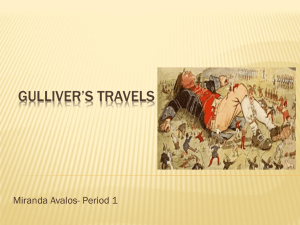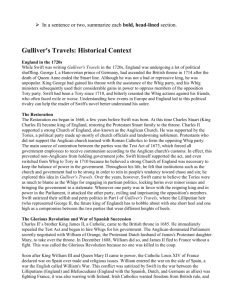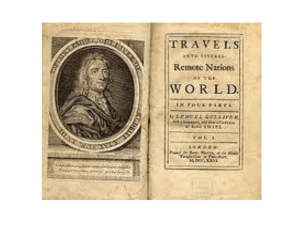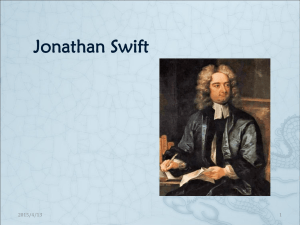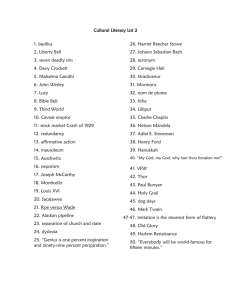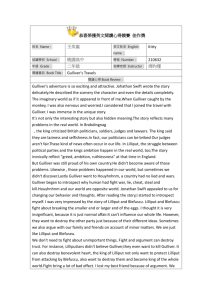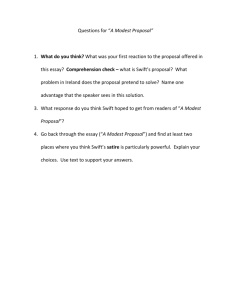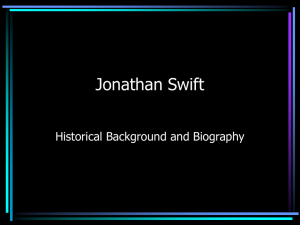GulliversTravelsClosereading.doc
advertisement
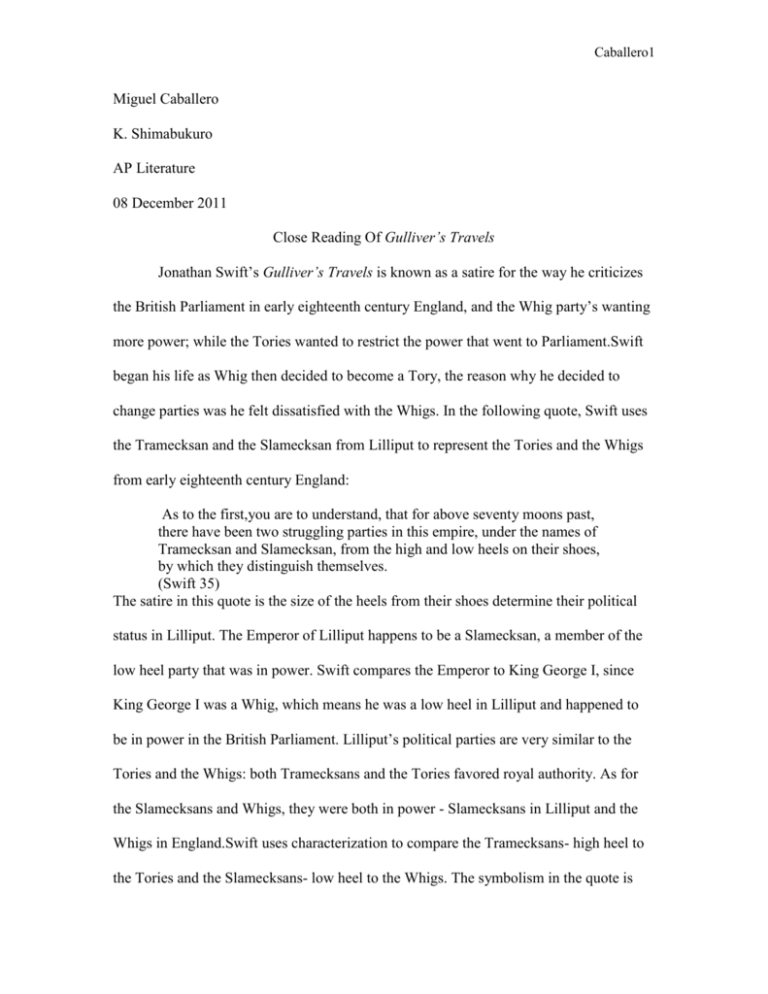
Caballero1 Miguel Caballero K. Shimabukuro AP Literature 08 December 2011 Close Reading Of Gulliver’s Travels Jonathan Swift’s Gulliver’s Travels is known as a satire for the way he criticizes the British Parliament in early eighteenth century England, and the Whig party’s wanting more power; while the Tories wanted to restrict the power that went to Parliament.Swift began his life as Whig then decided to become a Tory, the reason why he decided to change parties was he felt dissatisfied with the Whigs. In the following quote, Swift uses the Tramecksan and the Slamecksan from Lilliput to represent the Tories and the Whigs from early eighteenth century England: As to the first,you are to understand, that for above seventy moons past, there have been two struggling parties in this empire, under the names of Tramecksan and Slamecksan, from the high and low heels on their shoes, by which they distinguish themselves. (Swift 35) The satire in this quote is the size of the heels from their shoes determine their political status in Lilliput. The Emperor of Lilliput happens to be a Slamecksan, a member of the low heel party that was in power. Swift compares the Emperor to King George I, since King George I was a Whig, which means he was a low heel in Lilliput and happened to be in power in the British Parliament. Lilliput’s political parties are very similar to the Tories and the Whigs: both Tramecksans and the Tories favored royal authority. As for the Slamecksans and Whigs, they were both in power - Slamecksans in Lilliput and the Whigs in England.Swift uses characterization to compare the Tramecksans- high heel to the Tories and the Slamecksans- low heel to the Whigs. The symbolism in the quote is Caballero2 the low heel and high heel of the shoe, represents the political status in Lilliput of being either a Tramecksan meaning high heel or a Slamecksan meaning low heel. Swift uses symbolism in the quote from Gulliver’s Travels to show the meaning of the low heel and high heel of the Lilliputians shoes that determine their political status in Lilliput. A low heeled shoe represents a Slamecksan, meaning their political status is that they are in power on the island of Lilliput. As for a high heeled shoe, it represents a Tramecksan. They favor royal authority and supported Lilliput’s constitution. Another example of satire in Gulliver’s Travels is, “We apprehend his Imperial Highness, the Heir to the Crown, to have some tendency towards the High-Heels; at least we can plainly discover one of his heels higher than the other, which gives him a hobble in his gait.” (Swift 35). This means that the Emperor of Lilliput’s son had one low heel shoe and one high heel shoe. Swift uses the Emperor’s son to represent King George II, since King George II wanted to be placed in both parties. Even though, King George II was for the Whig party to please his father King George I, George II Favored both parties. Swift uses these examples of low heel and high heel shoes to represent the political parities of eighteenth century England the Tories and the Whigs. In Lilliput Gulliver claims that the Lilliputians prefer to choose fools for office over wise men, because they want to avoid corruption. Which is the reason why the Lilliputians political status is determined on the heel size of their shoes. In Gulliver’s Travels Swift indicates that the Emperor of Lilliput wears low heeled shoes that makes the Emperor a member of the Slamecksan party, having low heeled shoes also meant the he was in power of Lilliput. Swift characterizes the Emperor to King George I, since King George I was a Whig during the early eighteenth century. Caballero3 This indicates that King George I is considered a Slamecksan- low heel in Lilliput for being in power in the British Parliament,. Gulliver’s Travels uses historical context when comparing the Tramecksans and Slamecksans to the Tories and the Whigs. The Tories were a conservative party that wanted to restrict power to the British Parliament, but favored royal authority and supported the constitution. The Whigs were a liberal party that wanted more power to go to the British Parliament in the eighteenth century, although the Whig party was in power over the Tories in England during the eighteenth century. Swift also uses characterization in Gulliver’s Travels as he indicates to the the reader that the Tramecksans- high heels are the Tories and that the Slamecksans- low heels are known as the Whigs. The political parties in Lilliput, Tramecksans and Slamecksans are identical to the political parties in eighteenth century England. The Tramecksans and the Tories are similar, since they both favor royal authority. The Slamecksans and the Whigs are similar because they both are in power - Slamecksans in Lilliput and the Whigs in England. In the quote it mentions that the Tramecksans and the Slamecksans were struggling with each other on the island of Lilliput.Swift uses this to describe the conflict between the Tories and the Whigs in England, the Tories wanted to restrict power that went to the British Parliament and the Whigs wanted more power to go to Parliament. In Gulliver’s Travels Swift uses satire to criticize the Whigs during the eighteenth century. Swift wanted to show the feud between the Tories and the Whigs, which is why he created the Tramecksans and Slamecksans from Lilliput to represent the political parties in England during the eighteenth century. Not only did Gulliver’s Travels Caballero4 mention feud between two Struggling parties, but it also indicated how Swift described how the British Parliament and the Whig party were running things in England. Although Swift happened to be a Whig in the beginning of his life, he left the party because he felt dissatisfied and then joined the Tories, which is why the voyage of Lilliput in Gulliver’s Travels is considered a political satire. Caballero5 Works Cited Swift, Jonathan. Gulliver's Travels. New York/NY: Washington Square Press, 1970. Print. Caballero6 Writer’s Memo In my close reading of Gulliver’s Travels, I felt that my essay was good on describing the satire of the book by Swift. Although reading over my essay it sound that I was little repetitive in each paragraph about the political parties in Lilliput and England. However, I do believe that I did a good job explaining the satire and symbolism in the quote about the high heels and low heels. I feel that I did not include enough historical context of the reason why Swift wrote the book in the essay.
